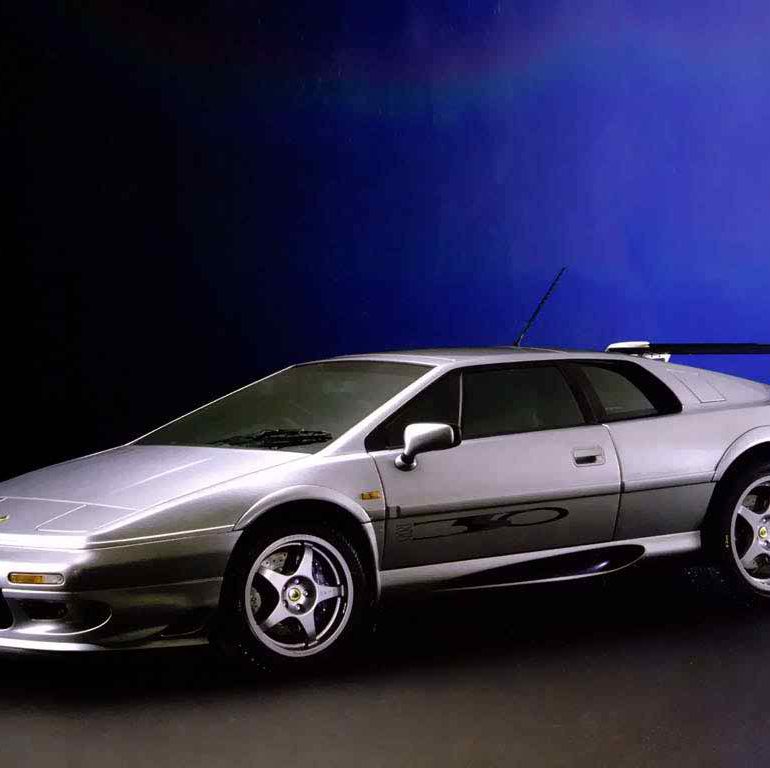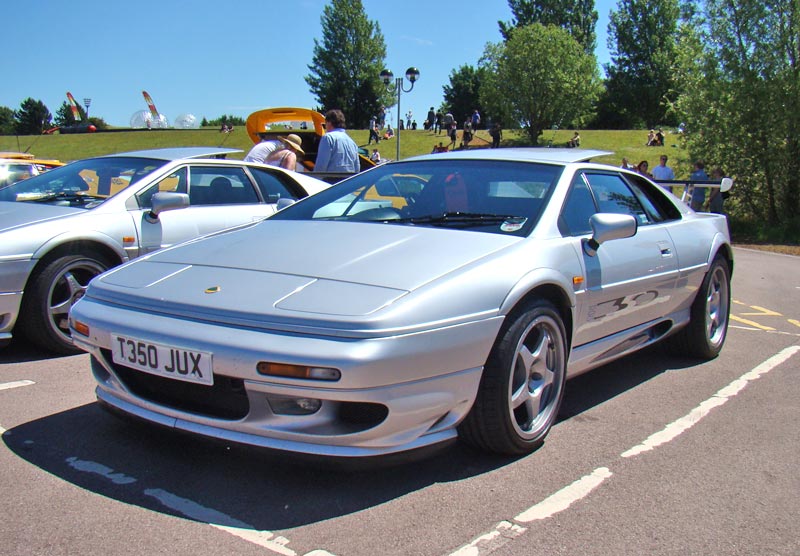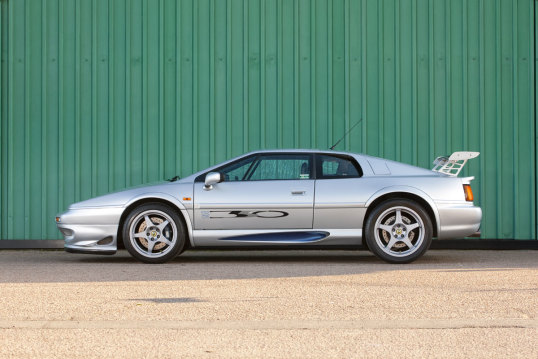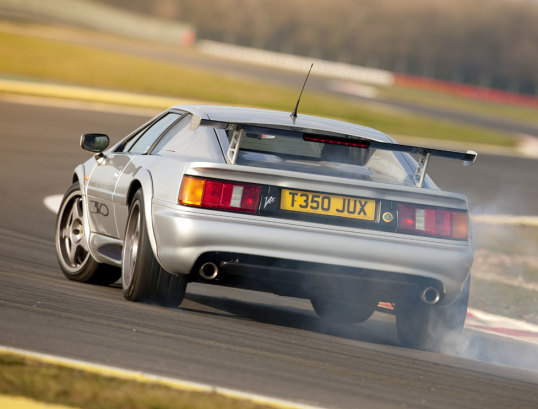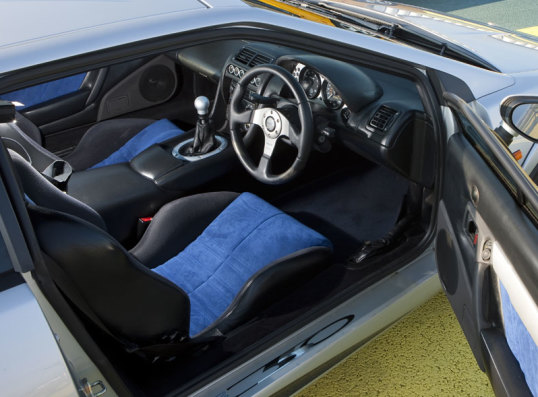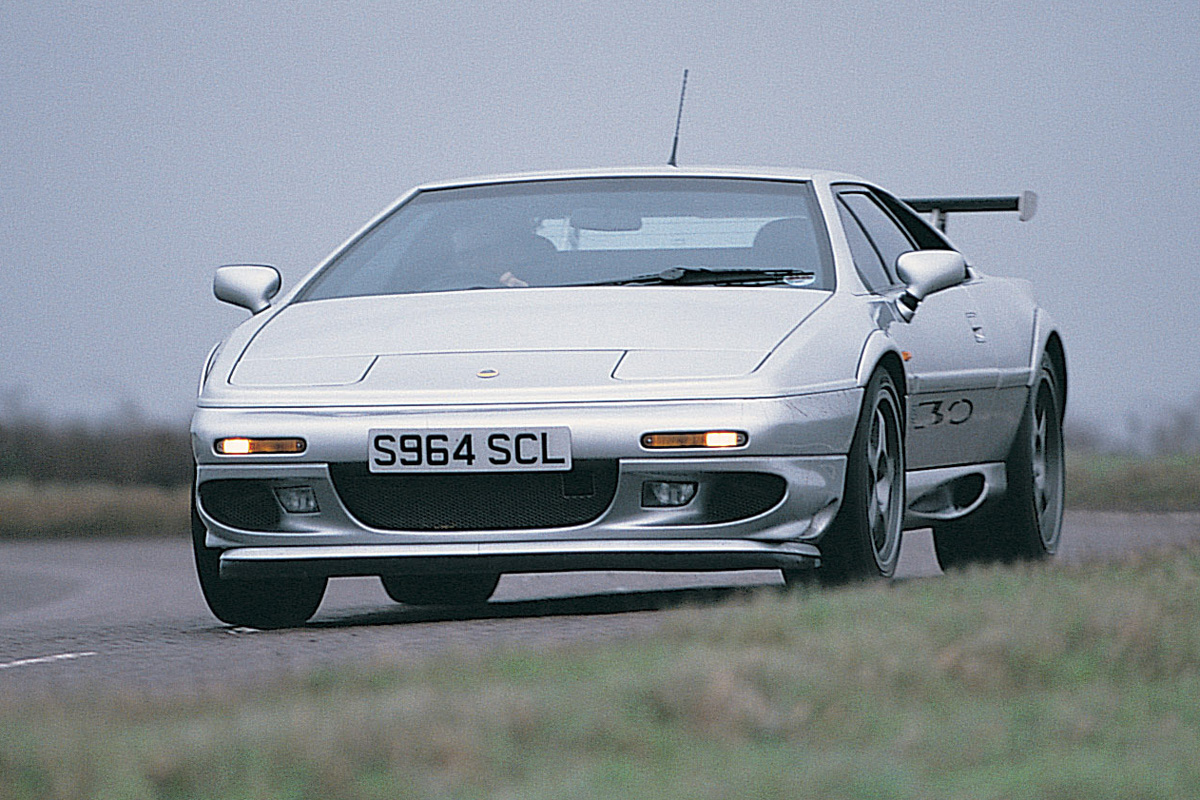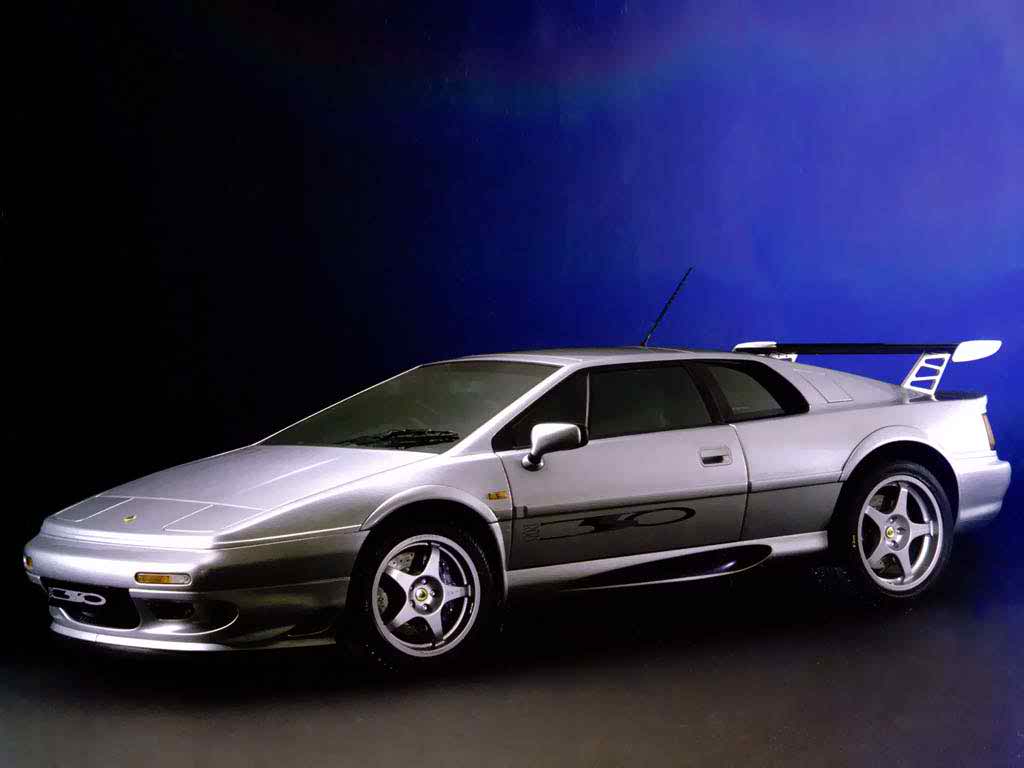1999 Lotus Esprit Sport 350
Years: 1999-2001
Names: Sport 350 / S350 / Type 85
Units: 42
Engine: 3,500 cc turbo V8
Power: 349 bhp @ 6,500 rpm
Torque: 295 lb/ft @ 4,250 rpm
0-60 mph: 4.7 seconds
The Esprit Sport 350 was hailed as the fastest, and the best, Esprit of them all. 160 lbs in weight was shaved from the standard V8.
Taking the V8 GT further, the Sport 350 was one of the most exclusive Esprits made. It featured the standard-spec V8 with blue-painted intake manifolds. What set the 350 Sport apart from the VT GT was a number brake, suspension and chassis improvements.
Externally, a large carbon-fibre rear wing was attached. This wing was highly similar to the wing used on the X190R racecar. Indeed the Sport 350 had one of the most prominent wings to adorn a road car.
Lowering the kerb weight was a primary design focus for Sport 350. For this goal, special magnesium wheels were employed. At the time of manufacture, these were the lightest wheels available on the market. Also reducing the weight, was a lightweight bodyshell. In total, the engineers managed to shed 80 kgs off the standard V8 GT.
Apart from the weight reduction, the other major change to Sport 350 was its braking system. Exclusive to the car are 320mm discs with blue-painted AP Racing Calipers. When Lotus engineers designed this car, they wanted it to be the fastest stopping Esprit. And it was. The car could go from 60 to 0 mph in just 3.2 seconds.
While exclusivity was offered with the Sport 350, it is ashame Lotus never tuned the engine beyond its standard specification. This is strange given the fact that every other aspect of the car was up-rated for track use. It was one of the closest cars to emulate the track experience on the road.
In total, only 50 Sport 350s were made, all having a huge 350 decal along the side of the car.
Related: Lotus Race Car List / Lotus Current Lineup / All Lotus Models / Lotus News
Pictures
Specs & Performance
| submitted by | Richard Owen |
| price $ | $£64 950 |
| engine | V8 |
| position | Mid Longitudinal |
| aspiration | Twin Garrett T25 Turbochargers |
| valvetrain | DOHC, 4 Valves per Cyl |
| displacement | 3500 cc / 213.6 in³ |
| bore | 81 mm / 3.19 in |
| stroke | 83 mm / 3.27 in |
| compression | 8.0:1 |
| power | 260.3 kw / 349 bhp @ 6500 rpm |
| specific output | 99.71 bhp per litre |
| bhp/weight | 280.32 bhp per tonne |
| torque | 399.97 nm / 295.0 ft lbs @ 4250 rpm |
| driven wheels | RWD |
| front tires | 235/40 ZR 17 |
| rear tires | 295/35 ZR 18 |
| front brakes | Vented Discs |
| f brake size | x 320 mm / x 12.6 in |
| rear brakes | Brembo Double Wishbones w/Coil over Dampers, Anti-Roll Bar |
| r brake size | x 320 mm / x 12.6 in |
| front wheels | Brembo Double Wishbones w/Coil over Dampers, Anti-Roll Bar x 21.6 cm / 17 x 8.5 in |
| rear wheels | R 45.7 x 21.6 cm / 18.0 x 8.5 in |
| steering | Rack & Pinion |
| f suspension | Double Wishbones w/Eibach Coil over Dampers, Anti-Roll Bar |
| r suspension | Double Wishbones w/Eibach Coil over Dampers, Anti-Roll Bar |
| curb weight | 1245 kg / 2745 lbs |
| wheelbase | 2420 mm / 95.3 in |
| front track | 1520 mm / 59.8 in |
| rear track | 1520 mm / 59.8 in |
| length | 4417 mm / 173.9 in |
| width | 1981 mm / 78.0 in |
| height | 1150 mm / 45.3 in |
| transmission | Renault 5-Speed Manual |
| gear ratios | 3.36:1, 2.05:1, 1.38:1, 1.09:1, 0.76:1, :1 |
| final drive | 3.89:1 |
| top speed | ~281.6 kph / 175.0 mph |
| 0 – 60 mph | ~4.7 seconds |
Driving a Lotus Esprit 350
Autocar Road Test. What They Said
For a company whose core reputation has been sculpted around lightweight, high-tech fast cars, the Esprit Sport 350 appears to represent something of an ultimate achievement for Lotus.
Developed from the already awesomely rapid V8 road car but encapsulating much of the brake, suspension and handling technology gleaned from two decades of GT competition experience, the Sport 350 is, in Lotus’s own words, ”the most extreme version of the Esprit ever to reach the market”.
It is also, in our words, the most outrageous, visually as well as financially – not to mention the most exclusive. In total Lotus will construct just 50 cars, all of which will be offered in the same silver/grey/blue colour scheme as worn by the £66,135 test car.
Yet despite the extra drama created by the huge carbon fibre rear wing and the new OZ Racing alloy wheels, the Sport 350 is little changed beneath the skin compared with the ordinary V8, bar its stiffer suspension, bigger brakes and a minor increase in torque in the lower gears. Its power output is exactly the same at 349bhp, although the 80kg reduction in weight is claimed to make this the most accelerative Esprit in history, if not the lightest overall.
The real question is: is it also the best?
DESIGN & ENGINEERING
Lotus may claim that the Sport 350 is the most extreme Esprit in history but in truth it is little changed mechanically from the regular V8. Beneath the rear deck lurks what is fundamentally an unmodified version of Lotus’s 32-valve twin-turbo 3.5-litre V8, the only difference being a mild increase in torque in the first three gears due to different mapping of the ECU system. Peak power is unchanged at 349bhp. with 2951b ft of torque arriving at the same 4250rpm. The Renault-designed five-speed gearbox is also unaltered.
Other than the changes to the suspension and brakes, it is therefore down to the visual aids to distinguish the Sport 350 from lesser Esprits, a task in which Hethel’s bold stylists will no doubt have revelled.
The most dramatic difference is the new rear wing, surely the most outrageous yet seen on a road car. It’s actually a close relative of the carbon fibre wing worn by the Type 115 GT racer and is mounted on gorgeous aluminium uprights for the pukka road racer effect.
At the nose there’s a deeper opening, providing the front end with even greater menace when viewed head on. while nestling within each wheel arch is a purposeful-looking OZ Racing alloy wheel wearing fat Pirelli P-Zero rubber.
Ultimately, however, it’s what sits behind the wheels that really sets the 350 apart from other Esprits. Up front, four-pot AP Racing calipers chomp on 320mm discs, while at the back there are similarly vast discs with two-pot calipers, not to mention a bespoke Kelsey Hayes anti-lock system. At last, it seems. Lotus has addressed the Esprit’s painfully obvious braking problems.
All Sport 350s get the same grey paint scheme in which blue streaks appear in the nose, along the side cooling ducts and on the Sport 350 decals on the doors and roof. The blue theme continues inside with the Alcantara/leather bucket seats. There are also tasteful splashes of carbon fibre and aluminium around the gear lever and centre console that provide a much-needed visual lift to the cabin.
Lotus breathes a little new life into an ageing design •••
PERFORMANCE/BRAKES
It would be easy to take one look at the acceleration figures that accompany this road test and dismiss the Sport 350 as being no more than competitive in a straight line relative to other £65,000 supercars. After all, the regular V8 rocketed to 60mph in 4.2sec and to 100mph in 10.3sec in 1996. In both instances, those times appear to eclipse the 350’s performance of 4.7sec and 10.7sec – disappointing, as the 350 uses the same engine and gearbox yet weighs 80kg less.
But there’s one redeeming factor to consider in this instance: the fact that the 350 was timed when it was streaming wet, unlike the V8 of three years ago. This alone makes the 350 blindingly fast, even by Esprit standards.
To duck below 5.0sec to 60mph and 11sec to 100mph in the pouring rain is loosely the equivalent of going sub-4.0sec to 60mph and below 10sec to 100mph in the dry. Which means that in reality only the mighty TVR Cerbera goes quicker for less money, and that’s before we’ve stirred in the 350’s most pungent ingredient: its in-gear acceleration.
Admittedly there’s a short pause in the high gears where not a lot happens when the throttle is opened sharply at low revs, but the instant the needle rises past 1800rpm you can feel and hear the two Garrett turbos go to work on the 3.5-litre V8.
By 2000rpm it depends largely on what gear you’re in as to whether the acceleration is strong, savage or eye-popping; witness the incredible 50-70mph top-gear time of 5.8sec, nearly 2.0sec inside a BMW M3 despite the fact that the engine is yet to get fully into its stride by then. Drop to third and this same increment takes a scarcely credible 2.6sec, putting the Sport 350 on level terms with all but the fastest superbikes and, therefore, comfortably ahead of most four-wheeled rivals. By any standards it is a ferociously; addictively fast car.
What a pity, then, that the performance is by and large so unpleasant to access. A recalcitrant gearchange means swopping cogs is not the joyful experience it should be. Worse still, the flat-crank engine sounds coarse and totally uninspiring when extended. This particular example also seemed to suffer from spurious vibrations in the mid-range that did nothing to enhance the impression of mechanical refinement. As with previous Esprit V8s we’ve tried, the engine is let down by its personality, not by its ultimate outputs.
However, Lotus does seem to have solved the Esprit’s braking problems. The big AP calipers snatch a little when cold, but generally they’re well up to the job, hence the superb wet-weather 60-0mph time of 3.2sec.
Very quick but needs more charisma. Good brakes at last ••••
HANDLING & RIDE
There have always been certain things that separate an Esprit’s handling and ride from that of its rivals. They usually involve its steering, its composure over rough roads and its balance on or around the limit of adhesion.
Take these aspects away, however, and the Esprit would not be the handling legend it is today. That makes it hard to understand exactly who Lotus sees the hard-riding and uncharacteristically uncompromising Sport 350 appealing to.
Even the regular V8 struggles to offer the sort of soothing ride and steering responses that so distinguish the lesser GT3 model from its stablemates, but by equipping the Sport 350 with even stiffer Eibach springs, not to mention wider tyres, Lotus has ended up worsening rather than improving the V8’s lot, certainly as far as its handling ability on the road is concerned.
But then this may not be entirely fair to the designers of the Sport 350. For if, as Lotus claims, this car has been designed to appeal to a small band of people who intend to drive on race tracks a lot and use their car only occasionally on the road, then it makes good sense. Ultimate grip levels are indeed higher than normal and body roll has been significantly decreased. There’s also a fair bit more composure over long-wave, high-speed undulations. That extra control would hardly affect a car on the road but is vital on a circuit, where speeds are higher.
Trouble is, good track cars rarely make good road cars and vice versa. Indeed, when it comes to the more delicate aspects of chassis behaviour it often works in reverse, and the 350. we’re sorry to admit, is a not-so-shining example of this.
Compared with mere mortal supercars, its power steering is still beautifully crisp and precise, but it has gained some unwanted rim kickback over rough roads. plus an over responsive quality just off centre, that will prove an unwelcome surprise to regular Esprit drivers.
Equally, the chassis is now pretty much incapable of absorbing a badly pockmarked British B-road. The fat Pirelli P-Zero tyres (235/40 ZR17s up front, 295/35 ZR18s at the back) now smack down heavily into ruts and are easily knocked off course, which means you end up having, to drive as you would in normal supercars, having to spot and steer around obstacles. Previously you’d just drive straight at them in an Esprit and allow the suspension to sort the rest out.
Better on a track than it is on road due to stiff springs ••••
COMFORT, EQUIPMENT & SAFETY
Climbing aboard the Sport 350 is, as with any Esprit, a uniquely taxing physical experience, with small door openings and wide sills. In fact, entry and egress are more awkward than ever because the 350’s part leather, part-Alcantara bucket seats are mounted fractionally lower in the chassis.
Once ensconced behind the new non-adjustable non-airbag Momo wheel, you quickly realise that the driving position, though marginally improved thanks to the narrower transmission tunnel, remains fundamentally flawed. The pedals are still ludicrously offset towards the centre of the car, while the footwell itself is as cramped as ever. And although the extra-high rear wing has improved rear vision slightly; overall the cabin is not well laid out, even though most of the instruments are now visible from behind the wheel, which wasn’t the case before last year’s reasonably successful interior rethink.
Nevertheless, there are signs that Lotus has tried hard to distinguish the 350’s cabin from that of lesser Esprits, some of which are more convincing than others. The new seats, once you’ve squeezed your way into them, hold most frames like a vice and provide terrific support when you’re pressing on.
Equally impressive is the attention to detail around the gear lever and centre console, where genuine carbon fibre and a mixture of blue Alcantara and bare aluminium have been used to great effect to lift the overall cabin atmosphere. The result is that the 350 has a unique quasi-racer feel inside.
Less convincing is the drop-off in mechanical refinement compared with other Lotuses. The alterations to the chassis have done as much to harm the Esprit’s ability to cover long distances in comfort as they have for its ride and handling, and the upshot is that the 350 is not a happy motorway cruiser due to its extra tyre roar and suspension rumble.
There was a time when Lotus build quality did not have to be examined too closely before the flaws began to emerge, but the 350 heightens the turnaround in quality control heralded by the Elise. By and large it is well enough assembled to stand comparison against any similarly priced rival, the paint. panel gaps and carpet finish all being beyond serious criticism.
Indeed, our only complaints in this area concern the lack of a passenger’s airbag and the relegation of air conditioning to the options list.
Cabin is cramped but characterful. Well made, too •••
ECONOMY
One of the most surprising aspects of the Sport 350’s fuel consumption is not that it drops below 16mpg when thrashed or that it can be made to eke almost 22 miles out of every gallon when stroked, but rather that it does not require super unleaded to give of its best. Often with cars of this ilk the engine will not run properly unless it’s fed with 98-octane fuel, but in this instance the Hethel V8 musters just as much fury on regular 95-octane unleaded as it does on 98.
Driven gently, it will run for about 350 miles between fills – not bad for a 170mph supercar.
Marginally better than average for a 170mph supercar •••
MARKET & FINANCE
It’ll be a bold, not to mention wealthy, individual who takes the plunge and spends the full £64,950 on a brand new Esprit Sport 350. The fact that supply is guaranteed by the factory to be limited to a run of just 50 cars will no doubt help bolster the residual values to a certain extent in the short term, but the basic truth remains that Esprits don’t hold their value as well as other similarly priced supercar rivals over the longer term. Compared with the Porsche 911 Carrera, for example, its value will drop like a stone over five to eight years.
The dealer market is also slightly misleading in that cars are often advertised at prices rather higher than the vendor is ultimately prepared to sell for, so make sure you haggle, even on brand new examples.
Don’t expect the Sport 350 to be anything other than expensive to run in terms of servicing and insurance. Having said that, garage bills have dropped markedly compared with the more labour-intensive four-cylinder Esprits.
Watch out for long-term residuals, they could tumble •••
Autocar Verdict
It’s an odd tool, the Esprit Sport 350. Having been delighted by so many examples of Hethel’s enduring mid-engined supercar over the years, you naturally tend to know what to expect from any new example that happens along: same poor driving position, same notchy gearchange, same dreadful rear visibility; same unrivalled ability to paint a smile across your face over a great road due to the unique blend of ride, handling, steering and straight-line performance.
Most of the raw ingredients are present in this latest version. Indeed, from a pure performance point of view the ingredients are more vivid than they have been at any time in the Esprit’s 22-year history. From a styling standpoint, too, this has to be the most dramatic, if not perhaps the prettiest incarnation of the car that not once but twice did the business for our James Bond in the ’70s and ’80s.
Back in those days, although the Esprit looked like a renegade from a Le Mans paddock, its intentions as a road car were as sharply defined as the angular extremities of its Giugiaro-designed body. It was a road car, pure and simple, a role to which it has remained true – right up until now.
For whatever reason, Lotus has attempted to blur the boundaries between supercar and racing car with the Sport 350, creating in the process what it defines as the most focused development ever of the Esprit. But we’d dispute that.
Yes, the 350 is focused in as much as it has one of the most attractive, well-made interiors ever to grace an Esprit. And with its vast rear wing, aggressive chin spoiler and bespoke paintwork, it also looks like it should be more of a riot than any other Esprit.
Yet in truth Lotus has gone too far with the Sport 350, particularly with its uncompromising suspension and steering. And the trouble is, without the usual soothing ride, forgiving handling and gorgeous steering it becomes more difficult to be tolerant of the flaws. Even the V8 engine starts to seem less impressive in the event.
We tried hard to adore this car in the way we’ve adored most other Esprits, but in the end even Hethel, it seems, can make mistakes.
Car Road Test 1999 – What They Said
They’ve lopped another 80kg off the Esprit, and added a carbonfibre tea-tray on the back, huge magnesium wheels, beefed up brakes and a brilliant cockpit. Is it, therefore, the best Esprit ever? story by Paul Horrell.
The new Esprit Sport 350 has the lightest magnesium wheels obtainable. It has a rear wing developed for a track car, made of carbon fiber, sitting on milled aluminium pylons. It has two-piece racing brakes discs. It has firmer suspension then ever. It also has — and this is a first in my experience — colour-coded loudspeaker cones, little circles of blue visible through the grilles at either end of the dash-top that exactly match the shade of paint on the AP Racing brake calipers. This may be the most extreme and sporting Esprit ever, but that didn’t stop Lotus having a few little visual larks on the side.
Let’s see now. In the past 3 years I’ve driven about nine Esprits, and I think they were of six different types. Lotus builds nearly as many new Esprit models as it builds Esprits. But the Norfolk toaster has always found a steady stream of fans, people who are so into the car they never consider anything else.
Even if the Esprit remains a painfully hard car to get into — and even harder one to get out of, thanks to high sills, far-back door posts and a handbrake that keeps making pre-emptive strikes on your lower calf.
Once you’re in, though, the best-ever Esprit interior wraps itself around you. There’s the facelift dashboard introduced a year back, which brought to the Esprit the novelty of instruments you can actually read. In this version the binnacle top is carbonfibre. Not the fake stuff but real woven black compositee, hard and tinny to the touch, a fineweave plaid mirage that reflects, glinting but not distracting, in the windscreen. Much of the centre console is the same, and the instruments are set in aluminium sheet. The gearknob is solid aluminium, too. All this garnish of lightweight materials certainly makes the thing feel like a race car, but probably saves the weight of one packet of Cheesy Wotsits. The strip-out doesn’t run as far as losing the air-con, mind, which is good. Given the way that vast near-horizontal plate-glass windscreen mists up without it, air-conditioning makes the Esprit several hundred percent faster.
A car with 350bhp has every chance of being very fast indeed, and the Esprit’s twin-turbo V8 has never disappointed in its mad speed-junkie thrust. The version in question gets colour-coded blue inlet manifold and cam covers, but the engine internals and power output are standard. Only the throttle response has been sharpened by re-programming the ECU. So the chip, justifiably, could be painted blue.
It’s down to the weight reduction, a worthwhile 80kg over the usual V8, to boost acceleration. Lotus claimss 4.6 seconds to 62mph and 10.1 to 100 (from rest) shattering numberss that talk of a step-off that makes if feel like the floor has given way beneath you, and high-speed acceleration to fire other traffic away behind you like a volley of cannonballs.
The rest of the car’s mods are designed to help you enjoy the speed more. The rear half of the chassis frame is made more rigid in the engine area, and that has allowed the stiffest-ever suspension settings on a road Esprit, sharpening up the corning on what is already one of the sharpest supercars of all.
Unsprung weight is shaved by those mag wheels and alloy bell-mounts for the (larger) discs, and the brakes themselves use AP Racing calipers, fed by the standard ABS. Tyres are Pirelli P-Zero in a super-sticky compound. Apparently Lotus was a bit stung when the press said the V8 didn’t have enough rear-end grip. Fitting 295/35 ZR18 P-Zeros certainly sounds like a reasonably thorough solution.
And yet, and yet. I’ve collected the Sport 350. It’s midnight. It’s raining. I’m in a particulary grimy part of London and every heavy vehicle in the borough has been spreading the roads with a black mayonnaise of clag. Pulling out of junctions, exiting from roundabouts — doing anything, really, that isn’t a straight and level 25mph — demands a radical driver recalibration. You have to treat the accelerator (aluminium, drilled, natch) like a piece of glass embedded with nails that has an unexploded grenade jammed beneath it. When the turbos spool up, at about 2000rpm, those huge tyres simply go sledging, spinning like catherine wheels — which only gives the engine more revs, and with it more boost, and so yet more revs. Trouble is, when you try and stay off-boost the clutch snatches and the engine likes nother more than to turn around, thumb its nose at you, and stall. And out on an urban dual carriageway you find it’ll spin its rear tyres clear through most of the gears. When they’re not screaming, those tyres drum like there’s cement being mixed inside your skull. OK, you can use an Esprit for everyday journeys, but it’s seriously sub-optional. Lotus has delivered a product with fully benchmarked cussedness and best-in-class aggro.
It’s easy picking through the Esprit’s supercar-cliche faults. Releasing the handbrake is like tying your shoelaces with your seltbelt on. If you’re tall you won’t fit anyway. The cabin fittings twitter like the queue for a Boyzone gig. The sticky gearbox and lousy over-shoulder vision mean a lunar landing is less of a daunting adventure than a three-point turn. But you will never, never find anything on this car that is as bad as its steering is good.
Few things are more important on a car this fast than the direction-finding mechanism, and the Sport 350’s steering is little short of miraculous. Gearing and weighting and accuracy are spot-on. But that’s hardly rockect science. The Momo wheel itself is the very thing, but you can buy that for a couple of hundred quid. The GT350’s stering hoists itself onto another orbit with the impossible absence of compromises. It suffers hardly at all from kickback or deflection on bumps and ridges, and yet the feel is deliciously natural and intimate: every little squirm of the front treads is passed up as a change in weighting to your hands, a little wriggle of the steering wheel’s rim. You can drive the car with glorious accuracy, which is nice; you can also drive it with marvellous confidence about the state of grip, which is much more than nice.
It’s all very fine knowing just what the front wheels are up to, but it would be a bit academic if the other half of the car is staggering about like a drunk in the dark, unlikely to go straight, unable to communicate. Not here. Despite the tyres’ scary hugeness and the overwhelming twin-turbo V8, the dark satanic forces clashing behind you, there’s a sweetness to the whole operation that keeps your mouth moist and your palms dry. On a smooth, dry road the grip and traction are phenomenal; when it’s wet or bumpy it releases its hold progresssively like no other mid-engined supercar.
The firm springs on the Sport 350 make it even sweeter and more precise on a smooth road than your standard-issue Esprit, but its gets shaken up more by a bad stretch, which slows you up. That wonderful Lotus suppleness isn’t so evident here. Mind you, we’re talking relatives. This car is made in Norfolk, where the roadmenders live a long way apart. In absolute measures, it copes well.
You have to get up very early in the morning to find a car that makes the Esprit seem slow. Once you’re properly rolling, there’s always boost up for grabs. The phrase ‘controlled explosion’ comes to mind. The first time you really press the accelerator it’s like setting off a fire extinguisher; something a bit irrevocable, a bit more than you bargained for. In truth, it can be controlled, modulated and regulated as you want, but there’s not the precision of a big naturally aspirated engine. Instead, there’s the feeling you’re reeling something in, rather than paying it out. How far does this torrent go? Not sure, to tell you the truth. There’s no red line and anyway the boost tails off a little beyond 5500 revs, so I tended to change up and surf away again.
Besides, there’s little ear-candy to be found at high revs. The Lotus V8 has never sounded too pukka. There’s an optional sports exhaust you buy from Lotus’s aftermarket catalogue, but this box-fresh Sport 350 did without. No, the compelling thing about this engin is the almost off-hand way it tosses out such a colossal rush. That and the way you can work the acceleration, meld it into cornering and braking that are just as brutal but smooth and perfectly under your control.
Obviously the Sport 350 makes you pay for your pleasure — arguably, it goes some way beyond the concept of mere pleasure. But it is a wretchedly inconvenient car, and ownership demands of you the sum of one arm and one leg: £64,950 is £5,000 more than the standard V8. Mind you, it’s but two-thirds the price of Mr Ferrari’s cheapest.
This is, no question, the best Esprit ever, as well as the dearest of all the variants. We shouldn’t be too surprised at the evolution, though, since the current-shape car saw the light in 1987. During those years Porsche has been building four entirely different generations of 911, and over at Ferrari the 328 has become the 348 has become the F355 (itself to be replaced by the 360). So Lotus has had some developing to do.
Top Gear Road Test 1999 – What They Said
The youth lingered, watching us photograph the silver Lotus on Great Yarmouth seafront before wandering over to give his opinion. “So,” he said, “you must be doing this for Max Power magazine, then?” Naturally, we put him straight in no uncertain terms but, to be fair, he had a point. It’s that rear wing, you see. As big and as in-yer-face as anything on a go-faster adolescent’s Nova.
But this wing is no glass-fibre affair. It’s made from the finest and lightest carbon-fibre in the land and is mounted upon “lightweight skeletal milled aluminium uprights’, if you please. Originally developed for the Lotus Type 115 GT race car, it now graces a limited edition run of fifty Sport 350 Esprits, a road car influenced by Lotus’s experiences in GT race championships and described by the company as “the most extreme and focused’ Esprit yet.
As well as that wing, Sport 350s can also be identified by their aluminium body colour, blue highlighting of the front and side air-vents, and an extra deep and low front spoiler. There are also blue brake calipers peeping out through new, five-spoke, charcoal grey, OZ Racing wheels, specially designed for Lotus and, apparently, the lightest road wheels money can buy. But don’t worry if these subtle differences are lost on you, for there’s also a massive Sport 350 logo adorning each door and the roof for quick and easy identification.
It is, however, the things you can’t see that make this Esprit special. It’s lost weight and clocks in 80kgs lighter than the standard, 1,380kgs Esprit V8. So even though the power of the twin-turbo V8 engine remains the same as before at 349bhp, the Sport 350’s power-to-weight ratio has improved. Lotus’s electronic engineers have also toyed with the engine management system, re- vising the torque levels in the lower gears for better acceleration.
A normal Esprit V8 has a claimed 0 to 62mph time of 4.9 seconds, but the Sport 350 shaves that to 4.6. So it’s bye-bye to any current Aston Martin, BMW, Honda, or Jaguar then. The trouble is, it could also be-bye bye to some important documentation. A few days with an Esprit Sport 350 and you could be left thinking up one hundred and one uses for that little plastic folder your driving licence used to live in.
At least the Sport 350 is well armed for that horrible, stomach-churning moment when you spot the police car. No, unfortunately it does not possess 100-mile-radius blanket Gatso- and speedtrap-disabling technology, but it does have very, very good brakes indeed ” four-pot calipers with a Kelsey Hayes anti-lock system are used, with huge new AP Racing 320mm two-piece brake discs which are vented and cross drilled all round. Hit the brake pedal hard and no matter what speed the car is travelling at, it will be back from the land of naughtiness into the realms of legality in a very short time indeed.
While the Esprit’s sheer speed is addictive, the V8 engine note isn’t. Unlike a Porsche, a Ferrari, a TVR or just about any other seriously fast sports car you could care to mention, the Lotus twin-turbo V8 isn’t anything special to listen to, even though it sits right behind your ears. There is, however, an optional sports exhaust which should create a bit more bark.
Nor is there much magic from the five-speed Renault ‘box which feels too cumbersome for a sports car. At least Lotus has significantly improved the clutch since we last drove a V8 Esprit, and the car no longer stalls as soon as you think about moving it, although it’s still a bitch to get into reverse.
As always in an Esprit, the steering feels superb, with more feel than just about any other car on the planet. The basic suspension remains the same “double wishbones at the front and transverse links at the rear” but stiffer, track-developed Eibach springs have been fitted. The ride feels firm and no doubt the handling is even better than before, but having only driven on roads that were either iced over or soaking wet, we must be honest and report that we didn’t exactly chart the far boundaries of the handling envelope.
Short of adding a roll-cage and racing harness, the Sport feels just about as close as you can get to a race car on the road. Being sealed inside the Esprit’s cabin with another large chap in the passenger seat is a cosy experience, to say the least. The dashboard is entirely carbon-fibre ‘and we’re talking the proper stuff here, not mere effect’. It’s even awkward to get in and out of like a real race car, but that’s just the Esprit being the Esprit. The lid covering the sizeable boot doesn’t always open and close properly, but that, too, is just the Esprit being the Esprit.
Lotus wants £64,950 for the Sport 350. It is a very good car and no doubt there will be 50 well-heeled, hard-charging Esprit fans out there who are prepared to hand over the readies for this special sports car. And, no doubt they will enjoy their purchases enormously. But if you have already set aside £64,650 for a new Porsche 911, well, we couldn’t really argue with the logic of your decision.


